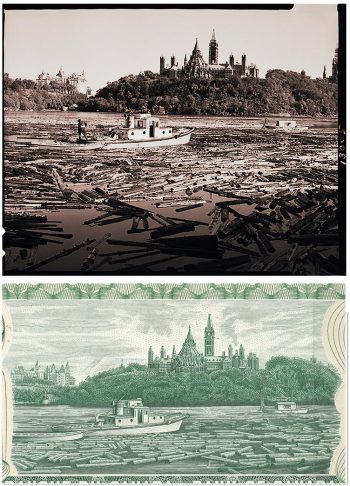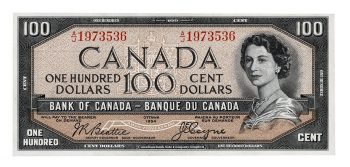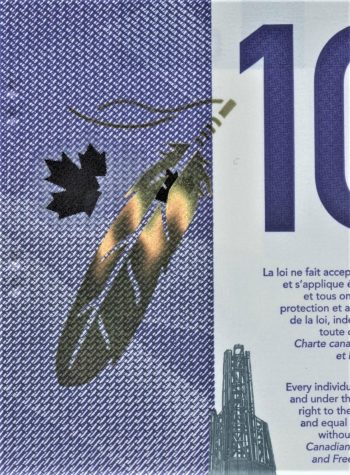From design to final product, bank notes and coins can be used to explore art, media and process.
Why use currency?
You can use currency—and even its security features—to show your students that art can be both practical and beautiful. Exploring the process of producing a bank note or a coin reveals aspects of photography, drawing, painting and engraving. Today, all these forms are brought together using digital imaging technology.
Creating a coin
For decades, the first step in producing a coin was a design sketch. This would be many times bigger than the actual size of the coin.
Once the coin design was approved, the artist would create a carving of it out of fine-grained plaster. This carving was used to make the stamping dies that made the actual coins.
For your class
Play with the idea of shallow relief engravings found in coins. Choose an animal to replace the Bluenose on the dime. What animal would best represent all of Canada for this coin?
Have your students:
- sketch the artwork using graphite pencils and paper to highlight reliefs
- use clay or plasticine to sculpt out the relief and textures
Creating a bank note
Before digital technologies were introduced in the process, the first step in producing bank notes—just like for coins—was often to produce a highly detailed hand-drawn or painted rendering of a proposed design. Sometimes, initial design efforts were more sophisticated and included collages of different media: engravings, paintings, illustrations, machine-made patterns and printed lettering.
Explore engraving
Engraving a metal plate for printing requires great skill and painstaking accuracy. Basically, the engraver draws an image onto a metal plate using sharp tools. These tools cut into the metal, producing scratches, cuts and furrows. The engraver creates shadows with cross hatching and a sense of dimensionality by engraving varying depths of ink-carrying cuts. Ink is applied to the plate, removing the excess so ink remains only in the cuts. The plate is then pressed against paper with great pressure. The image is transferred onto the paper, resulting in raised ink. This is called intaglio printing.

The hand-engraved scene on this note began as a photograph. An engraving machine created the geometric patterns (“guilloche”) and the number was yet another engraving. All were combined onto a single printing plate.
Source: 5 dollars, printing plate, Canada, 1954 | NCC 1977.90.6 5 dollars, Canada, 1954 | NCC 1967.43.1
For bank notes, engraving serves not only to reproduce photographs, paintings or illustrations, but also to create a printed piece that is extremely difficult to counterfeit. Until the middle of the 20th century, the security of a bank note depended on the extraordinary skills of the engraver. To make a fake note look believable in that era required a forger to have talents equal to or better than the engraver who made the original.

This counterfeit by master criminal Edwin Johnson was so good that it was considered better than the original. The designs around the numbers were originally machine-made, but Johnson was a skilled engraver and reproduced them by hand.
Source: 4 dollars, counterfeit, Dominion Bank, Canada, 1871 | NCC 1967.50.2
Watch Canadian Bank Note Company master engraver and art director Jorge Peral create a portrait of Sir John A. Macdonald in steel. Then see the results.
Source: Bank of Canada
We expect modern bank notes to have engravings on them, but only portraits and some lettering are still done that way on Canadian notes. Lithography is now the printing process of choice for bank notes for financial and security reasons. In lithography, image areas of a printing plate hold ink while blank areas are made to repel it. One key aspect of lithography is that it can create amazingly complex colour schemes that make money far harder to counterfeit. However, some parts of Canadian money are still engraved such as the portraits and some lettering. This process is called intaglio printing, and it cannot be duplicated by any other process.

One side of this note required three printing processes. The top image shows the intaglio layer. The middle image shows one of the lithographic layers. The bottom image shows the final note with serial numbers added by a letterpress, which is like a rubber stamp.
Source: 50 dollars, proof 1974, banknote, Canada, 1975 | NCC 2011.67.1251, NCC 2008.66.49, NCC 1975.70.1
For your class
Watch this video about engraver Yves Baril to learn more about the [engraving] process.
- To practice engraving have your students etch a drawing on a Styrofoam plate.
- Using a hard roller, apply paint to the untouched surface. Take care not to get paint in the engraved parts of the plate.
- Press the inked plate down on a piece of paper for a quick and easy reversed print.
Try out digital painting or drawing using a free application on a smartphone or tablet to practise stroke width and textures used in today’s digital engraving.
From scissors and tape to Photoshop
Before the era of digital illustration, artwork from original photographs and illustrations was needed to produce bank notes. Engravers first recreated the original photograph as an illustration that stressed dark and light shades to make it suitable for engraving. They often needed to adjust the image to suit the horizontal format of older bank notes. Along the way, the engravers might have removed the odd tree or telephone pole, added clouds or altered the foreground to create a more comfortable sense of perspective.
Nowadays, bank notes are almost entirely designed on a computer. Even engraving is done using pressure-sensitive tablets and software that delivers a digital file to a computerized engraving machine. Big changes are made to the design as easily as little changes. And when engravers make mistakes, they just click undo.

If you compare the original photo with the engraving, you can see that the engraver removed the people and many of the logs, added clouds and contrast to the trees, increased detail in the buildings and later put a flag on the Peace Tower.
Source: photo, “Paper and Politics,” Malak Karsh, Canada, 1963 NCC 1993.56.297| 1 dollar, Canada, 1973 NCC 1973.122.1
Watch as our curator re-enacts the making of a photo montage used to create the single landscape image for the back of the 1969 $20 bill.
Source: Bank of Canada Museum
For your class
Have students create their own bank notes using existing elements:
- Explore different award-winning, international bank notes for inspiration on layering symbols, imagery and photographs into one final product.
- Take multiple photographs of the same image to create a collage for a design that works best for a bank note.
- Select a photograph and create a simplified drawing.
- Layer them all together for a single, complex note.
This can all be done digitally if your class has access to a scanner and photo-editing software.
Designing within requirements
Bank note design involves far more parameters than most design processes. The creative test is to include imagery that reflects our country while ensuring the notes have accessibility and security features. This makes for an interesting design challenge: do you work around the security features or take advantage of them?
Creativity with colours
Each of Canada’s bank note denominations has its own colour palette, which has remained mostly unchanged since 1937. The bold, bright colours serve as an accessibility tool to help people identify specific notes. The imagery, tone and engraving therefore need to fall harmoniously into the colour palette and can drive much of the design.
But not everything on the note must be depicted in the dominant colour. Designers just need to find ways to integrate that colour into their layouts.
For your class
Play with vertical formatting of images to help your students gain a new perspective and assemble them into a new design:
- Take a horizontal bank note and make it a vertical one.
- Assign small groups of students to pitch a design based on a colour palette. Encourage them to pitch imagery, symbols and photographs in a presentation to the class.
- Explore the historical use of landscape illustrations on bank notes with this overview. Then choose a new image to represent contemporary Canadian landscapes on a vertical bank note.
- Assemble the new vertical note.
Designing with security features
Security technology for bank notes is evolving at an accelerating rate to stay ahead of counterfeiters. One of the greatest challenges for any bank note designer is to integrate anti-counterfeiting technology into their artwork, embedding state-of-the-art security features while keeping the note beautiful. Thoughtful designers have taken advantage of aspects of this technology to create beautiful elements of the note.
For your class
- Ask your students to spot the security features hidden in our bank notes.
- Have your students design their own bank note while integrating security features. Then have another class spot the security features hidden in the students’ artwork.
- Take an original bank note design and remix it for a modern audience. Include artistic imagery that could also be used as security features to prevent counterfeiting, such as guilloche, raised ink or micro text in the background.
Inspiration in your wallet
Canada has grown into a nation with its own symbolism, artists and creators. And our currency reflects this. Exploring the intricacies in the artwork on the bank notes we use to pay for goods and services might inspire future artists. After all, their work might very well be on the next coin or bank note!
The Museum Blog

New acquisitions—2024 edition
Bank of Canada Museum’s acquisitions in 2024 highlight the relationships that shape the National Currency Collection.

Money’s metaphors
Buck, broke, greenback, loonie, toonie, dough, flush, gravy train, born with a silver spoon in your mouth… No matter how common the expression for money, many of us haven’t the faintest idea where these terms come from.

Treaties, money and art
The Bank of Canada Museum’s collection has a new addition: an artwork called Free Ride by Frank Shebageget. But why would a museum about the economy buy art?












